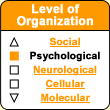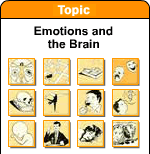|
|
|
|
 |
Fear,
Anxiety and Anguish |
 |
|
|
|


The word "emotion" does
not correspond to anything concrete in the brain. It is simply
a useful label for a set of subjective phenomena that all
of us have experienced.
A useful label, just like the words “perception” and “memory”,
but one that does not refer to anything specific on the
functional level. For example, there is no one system for
perception in the brain, but there are several specific
neuronal systems, such as the visual, auditory, and olfactory
systems, each of which evolved to solve very specific problems
that animals had to face.
The same is true for the various classes
of emotions (fear, anger, disgust, etc.) which depend on
various systems in the brain. The parts of the brain that
make us feel fear and hence defend ourselves from danger
are not the same ones that make us feel attachment and desire
and hence drive us to reproduce. |
|
|
| WHEN FEAR TAKES THE CONTROLS |
|
The behaviours that human beings display when they are afraid are
very similar from one individual to another, even in different cultures.
If something scares us - a sharp noise, for example - our first
reaction is to stop what we were doing.

In general, we almost immediately turn toward the source of the
noise and try to assess the actual danger that it represents. We
do all of this very quickly, reflexively, without any conscious
effort or will.
If the source of the noise seems to pose a real threat, we freeze
in place and try to assess whether we can flee or
hide.
Finally, if we come into direct contact with
the source of the noise, and it turns out to be a genuine threat
such as a bear, we have no choice but to fight,
or in other words, to adopt an aggressive defensive behaviour to
eliminate the threat or make it go away.

This sequence of behaviours triggered by
fear is very common and produces
the same physiological responses in all animals.
| While the ultimate
causes of our emotions (from an evolutionary standpoint)
are related to our survival, the proximal causes (from the
standpoint of our motivations)
are more to evoke an emotional change in other people so
that they will behave in a way that benefits us. |
|
|






